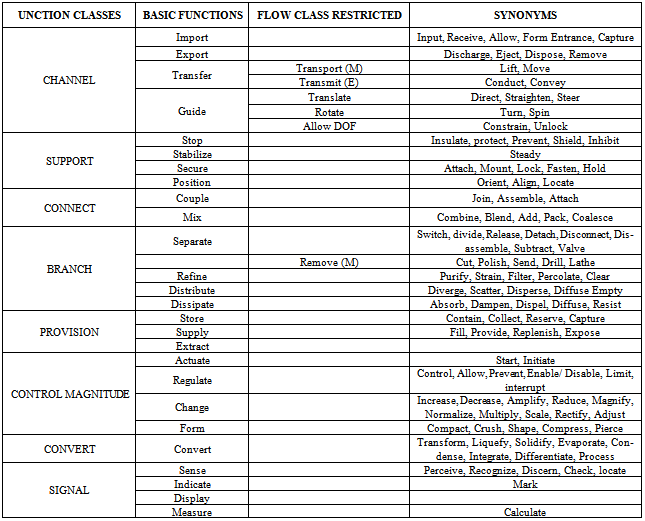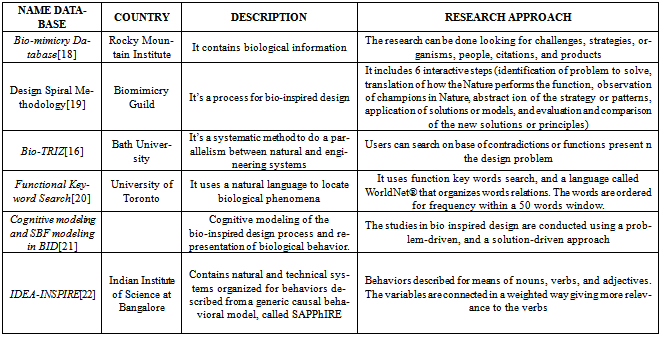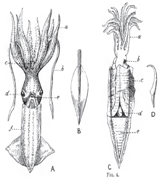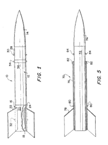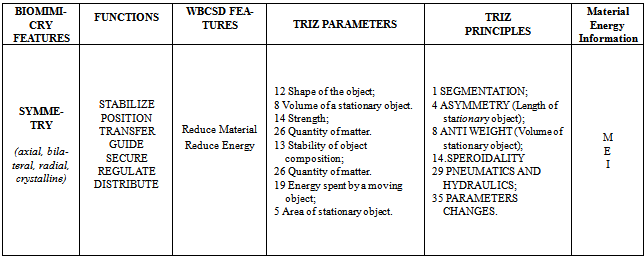-
Paper Information
- Paper Submission
-
Journal Information
- About This Journal
- Editorial Board
- Current Issue
- Archive
- Author Guidelines
- Contact Us
International Journal of Information Science
p-ISSN: 2163-1921 e-ISSN: 2163-193X
2011; 1(1): 1-11
doi:10.5923/j.ijis.20110101.01
Bio-inspired Design Methodology
Maria G. Trotta
Politecnico di Torino, DISPEA, Torino, Italy
Correspondence to: Maria G. Trotta, Politecnico di Torino, DISPEA, Torino, Italy.
| Email: |  |
Copyright © 2012 Scientific & Academic Publishing. All Rights Reserved.
The necessity to be competitive in the market pushes companies to increase the degree of innovation and at the same time to think about new products in terms of durability and efficiency. New product development is part of a strategic process called product lifecycle management, which starts with the idea generation phase. Considering this first step, for the reasons of the great impact in reduction of costs and the potential high return of investment, the goal of this research is to formulate a methodology which might be used during the idea generation phase to create innovative concepts. This methodology focuses on geometrical definition and problem solving. It takes its inspiration from biological systems to maximize durability and efficiency, and from technical systems to drive innovation. It can be used in virtual and shared environments to support designers, innovators and process developers.
Keywords: Creativity, Innovation,Biomimicry, Biomimetics,Design Methodology, Sustainability, TRIZ
Cite this paper: Maria G. Trotta, Bio-inspired Design Methodology, International Journal of Information Science, Vol. 1 No. 1, 2011, pp. 1-11. doi: 10.5923/j.ijis.20110101.01.
Article Outline
1. Introduction
- Design activities exert considerable influence on the well being of human life. Developments in design knowledge are expected to trigger an evolution from computer aided to knowledge-based design systems[1]. The design activity of the concept generation provides a creative forum for designer and engineers. They need to define with accuracy the problems to solve, in order to understand accurately relations, flows, and performances. Suddenly, in order to avoid preconceived solutions and psychological inertia, due to the finite experiences, creative methods drive designers through the problems abstraction and after through the abstraction of solutions. Different methodologies have been studied in order to combine explicit knowledge for improving this process. The required knowledge may be of different kinds, located in different scientific areas, and derived from different sources such (people, products, processes). The efficacy of using biology as a knowledge source - often combined with other sources - has been demonstrated since the very beginnings of human history[2].Our methodology combines biological and technical knowledge. It combines TRIZ problem solving approach with the Bio-Mimicry approach, in a way that is compatible with both (Vincent, 2005). Therefore, it is important to think in terms of using information related with biological functions, and then translate those in terms of technical functions to solve design related problems. With the aim to give more importance to the spatial variable, the reordering will give top priority to the most important variable of the space. Connections among different domains provide logic reasoning abilities that can be visualized and analyzed in a CAD environment. This is important because currently designs are created and visualized in CAD systems.CAD environment is a connection ring between the Product Lifecycle Management functions and other manufacturing functions. This provides the possibility to create an integrated functional structure. It might be useful to underline here that PLM technology has emerged from the growing interest and dependency of companies on CAD and PDM systems; and, that ever more knowledge has been embedded into the CAD environment using PDM technology. The modern CAD systems are constraint-based models in which every element may be connected by means of parameters, relationships and references[3].
2. Purpose of the Study
- The concept generation is connected with companies’ strategic thinking, and with the future impacts in terms of return of investments that it may produce. How the concept definition may influence all parameters related to a future product and subsequent outcomes can be easily understood. Hansen presented a comprehensive procedure, for the concept generation (Hansen, 1965), based on the specific problem definitions, in which the definition of internal and external relations is mandatory before any decision can be made. Improvements in information technology systems allow designers to enjoy greater freedom and to enhance the creative process, and research activities to generate new concepts. Information technology can improve the capacity of humans to understand and solve problems, making shorter the transition among different type of knowledge belonging different disciplines. Methods for the concept generation may be more intuitive (such as brainstorming, morphological maps) or logical (step-by-step guided). The present research will focus attention on the latter, in particular on TRIZ, the Russian step-by-step guided theory of inventive problem solving. The objective of this paper is to create a new methodology that can build a bridge between technical and biological systems. It will concentrate on the geometrical structures and principles that may be introduced to the CAD environment, which offers a useful link with the Product Lifecycle Management (PLM).
3. Problem Solving
- Problem solving is a characteristic of human research activities, engineers are looking for answers that can be utilized by designers in the definition of new tasks. In Biology appends the opposite: the initial state is represented by the answer, and one is trying to find out the problem.Problems present an unwanted initial state, a desirable end state and obstacles to get from one to the other. Problem definition involves a formal description of the initial state and end state- sometimes there are intermediate states as well. Problem solving essentially means removing those obstacles, which are often characterized by varying degrees of complexity and uncertainty. Access to formalized knowledge is vital to define formally the state of the problem. The problem solving process involves a step-by-step analysis that starts from a comparison of the problem with what is already known. Available knowledge related with possible solution principles is useful to clarify the nature of the requirements. Automated problem solving and generic problem solving have been described also by Simon and Newell (1972)[4]. They state that generic problem solving has to focus on the description of the current situation and the desired one in order to change the system acting to be closer to the goals.
4. TRIZ
- The TRIZ, theory of inventive problem solving claims that inventive problems can be codified, classified, and solved methodically with a process of abstraction, of the contradictions, and inventive principles of solutions[5].
 | Figure 1. TRIZ method in Inventive Problem Solving Process |
4.1. Figure Captions
- The sequence of steps belonging to the TRIZ method is represented in Figure 1. TRIZ is based on the existence of patterns of innovation based on principles. The theory comes from the Altshuller’s study of thousands of patents. The value of the invention is given from the main goal to reach an ideal value in design without harmful functions and overcoming any contradictions.
 TRIZ is based on the on the transformation of specific problems into generic ones, it relates functions with potential structures or shapes, and specifies the principles that should be used. TRIZ offers the possibility to consider physical and technical contradictions for the concept definition. Nevertheless, since we need to focus on the geometrical definitions related to CAD modeling, we are only considering the physical contradictions in order to use those in during a CAD modeling definition[6].
TRIZ is based on the on the transformation of specific problems into generic ones, it relates functions with potential structures or shapes, and specifies the principles that should be used. TRIZ offers the possibility to consider physical and technical contradictions for the concept definition. Nevertheless, since we need to focus on the geometrical definitions related to CAD modeling, we are only considering the physical contradictions in order to use those in during a CAD modeling definition[6].
|
4.2. Table Captions
- Altshuller identified administrative, technical and physical contradictions and organized them in 39 parameters[7]. He found that to detect solutions there are 3 separations among physical principles that are divided by the time, space, conditions.This paper will focus only on the principles related with space, with some exceptions that have been also included. The exceptions are related with the principles 11 Beforehand Cushioning, 15 Dynamics, 26 Copying, 29 Pneumatics and Hydraulics, 31 Porous material, 32 Colors changes, 35 Parameter changes.
5. Innovation and Efficiency
- Innovation is driving the lifecycle of products to make it become shorter, pushing for a premature obsolescence. Additionally, innovation is a key factor that is adopted by companies to ensure improved product performance on the market. Innovation could be characterized as the capability to define new solutions, new relations, and the further they are from previous solutions and the field in which they are operating, the higher the degree of innovation[8]. In order to produce innovation, companies must make use of different sources such as people, products, and processes. The idea of collaborative and open innovation through the use of teams is a dominant trend. Exchanging collective knowledge within the team promotes collaborative imagination[9].Since computer applications are used heavily during the concept generation. Consequently, developers need to support the use of formalized knowledge to support the team’s capacity to create new relations and solutions. Intelligent network systems are available to support people during this process and semantic processors are used to achieve this. The formalization of knowledge can simplify the connection of information with tasks of the design workflow. A commonly used formalization technique is a semantic net in which we can visualize these relations as connections and knowledge as nodes for the representation. The vocabulary follows rules of a formal semantics to facilitate the computer processing of information. One can also represent knowledge formally using ontology. Numerous languages have been developed to do this. One of the most commonly used languages is OWL. The basic elements of the OWL are classes, properties, and instances of classes, also known as individuals. Knowledge is encoded using axioms to describe the elements and their relationships. Taxonomies are used to classify hierarchically classes and properties.Visualizing relations is often helpful for checking the complexity, the qualitative state of a system, and where the problem is located. TRIZ, the theory of inventive problem solving proposed by Altshuller is based on the view that innovation is guided by principles that are repeated with different relations, in different areas, providing different solutions. For these reasons, they can be learned. Considering the consumption of energy and materials like the problems to solve, we can use TRIZ and all the parameters and principles from the efficiency point of view in order to solve the big contradiction of innovation that often seems to be in opposition with that of durability. Considering the evolution of product efficiency on the temporal axis, we can realize that the efficiency for every individual product is increased. At the same time the number of products present on the market also increases, on the other hand the lifecycle becomes shorter (Jevons’ Paradox). If the goal is to create more efficient product systems, it is important understand what similarities are present among the areas that we want to relate together. The common aspects and differences among design, biology, and innovation may allow us to create a common language that could constitute the basis for achieve this goal. Considering Life Cycle Assessment, Bio mimicry and TRIZ, the concepts of functions, flows, and relations is commonly used and in particular the “Main Function” is defined as one without which the system loses its meaning. A system is complete if every function is directly connected with the principal one. The notion of “Flow” consists in an amount of material, energy and information with a dominant path. An important role is also covered by “Relations”, relevant for the fulfillment of function and to exchange the flow. Information is generally given by signals that are the physical way in which it is supplied. Information provides the internal decision making capability. Signals are received, prepared, compared or combined, transmitted, displayed, recorded[10].To summarize, the definition of the functional model leads us to understand the complexity and quantity and state of interactions among the elements; relational boundaries to allocate or exchange resources, energy and information; decomposition of problems, enhancement of abstraction.
5.1. Table Captions
- In the Table 2 are shown the kinds of flows that can pass through a product system.
6. Functions
- Depending on the complexity of a problem, the structure of functions may be less or more complex. Division into functions and sub-functions facilitates the search for solutions. The definition of the optimal (with efficient performances) functional structure is an important part of the concept definition. The meaning of functions, in a product system, is related to what the product does. That is usually expressed by an active verb with a noun. A function puts in relation, by means of a task, the available resources and the desired output as shown in Figure 4.The system of functions can be divided into a hierarchical classification, in which each sub-function corresponds to a subtask. The so-called “If-then” relationship may clarify the concept of sub-function; if a function is performed then another one is activated[10].
 | Figure 2. Generic black box model |
|
|
7. Integration between Biology and Other Fields
- Biological systems are being studied by different fields in order to construct useful models and simulate possible reactions, performances and so on. Some examples include biomechanics which is the application of mechanical principles to living organisms; biotechnology which is the study of applied biology, using living organisms in engineering, technology, medicine; mathematics which has developed models that describe the biological model formation; computer sciences, creating simulation to understand the growth of biological cells and so forth.Biology is more descriptive than engineering which is prescriptive, but they share the same prime goal: problem resolution. The major reason of bio-mimicry is to look at nature to find technical solutions.
7.1. Bionic, Bio-mimicry
- Bionic (Schmitt, 1969) is a bio-inspired field that involves engineering and science. Bionic is a multi-disciplinary science based on the proprieties, processes, functions, organizations, and relationship of biological systems. The term bionic was introduced by Major John Steel of the Aerospace Division of United States Air force in the 1960. Bionics sees nature as an answer for building sustainable or not man-made creations[14]. The most recent term of Bio-mimicry was coined by biologist Janine Benyus (1997) and it comes from bios that means life and mimesis that means imitation. This new field represents an inspiration for human methods, processes and designs to study examples and material in nature to apply them in the man-made environment in order to reduce the environmental impact[15]. Evolution in Nature has already done a great number of inventions that may be used to find solutions for the technical problems. In nature the classification can be hierarchical, parametric or combinatorial. Several books, published from the 1870 onwards, have examined the subject, among these: “Homes without hands” and “Nature’s Teaching: Human Inventions anticipated by Nature” written by J.G. Wood; ‘Natural Theology”, published by Paley’s, was filling the examples from the structural and mechanical point of view; “Design in Nature”, by J. Bell Pettigrew’s published in the 1908 shows the handiwork of the systems in the animal body.
8. State of the Art, Integrations between Biology, Design and Innovation
- Several researches have tried to collect biological information with the aim of using those in the problem solving process, often the efforts are focused on the creation of comprehensive repositories that are collecting data related with several fields. An interesting research has been conducted by the department of Mechanical Engineering, Centre of Bio-mimetic and Natural Technologies University of Bath, has developed a BIO- TRIZ matrix that derives from PRIZM (reduced versions of the standard 39X39 Matrix of Contradictions)[16].Bio-TRIZ is the methodology that has been developed analyzing 500 biological phenomena covering more than 270 functions; they analyzed more than 2500 conflicts and their resolutions in biology ranked by level of complexity. They established six operational fields in which every object is put in relation by means of an action with a subject. They underlined that only principles of spatial composition are similar in both the biological and technical systems[16]. They further clarify the distinction between the meanings of cause and effect in the technical system and in the biological one. In technical systems for instance the ambient pressure is the cause of the boiling point of pure water which is the effect. In biology an effect is the problem to be solved by the organism and the cause is the method of solution. The department reorganized the matrix using a condense version of the TRIZ principles[17].
8.1. Table Captions
- In Table 4 we can see the main database that have tried to collect biological and technical samples in order to provide useful references for new products developments.
9. PLM and Knowledge Management
- The concept of relational database is strictly connected with that of Semantics. Semantic Network is a net in which the arcs are the meaningful relations between nodes that represented objects. Connections among data enable analysis and conclusions to compute information in a logic reasoning process. Knowledge belonging to different disciplines could be integrated and available, and ontology based collaborations are possible. Tools such as PDM (Product Data Management) have been developed for data accesses and collaboration during the new product development process. PLM enables users to search the repository models for information related with the best practices, functionalities in order to reduce time losses and costs. Constraints are extracted from CAD environments such as NX to define the ontology in order to interpret them in a computer language.Standards for the Exchange of Product Information provide for instance the Application Activity Model that qualifies the Product Design Ontology. The CAD Model can also contain the geometrical features connected with the metadata. Once the modeling is completed, several simulations could be processed with the aim to understand physical properties or engineering specifications. One example that has been developed for the Methodology for product Family Ontology using the formal concept analysis in order to reduce complexity, lead time and development costs (Nanda at al. 2006)[23].Product Design Ontology has been modeled in conformity with On-To-Knowledge (Sure et al. 2003). OTK may be defined for the ontology design as an interactive process composed of four phases: • The concepts and the hierarchy of relations are established;• The modeling of the product design ontology is expressed;• The ontology is validated in comparison with the goals; • The evolution of the ontology is maintained in line with scenarios.The core components of Products Design Ontology are shapes representations, shapes processing tools (algorithm), tasks, conditions (geometric) and groups.
10. Proposal of Methodology
- The present methodology will focus mostly on the domain of the bio inspired formal features taken by Nature in order to solve problems connected with an efficient use of energy, resources and information. The aim of this methodology is to select the most used and effective geometrical features from biological systems, that can exceed in performances, and connect those with part of TRIZ principles and WBCSD requirement of sustainability.Before to introduce the methodology is important make a brief survey in the method of classification, introduced in natural history. The quality of wholeness (of integrity of a unity in structure, in which parts contribute in composition and functions) was a central concept in the natural history of Aristotle. Much of the eighteenth-century natural history was devoted to the question of classifications culminating with the work of Buffon and Linnaeus. Aristotle formulated the idea that variety of animal species derived from an exhaustive recombination of limited number of different kind of component organs. This suggested the idea of archetypes[24]. Aristotle, simultaneous, adopted also the idea of harmonious and coherent relations between all the parts and the whole, even if the idea of permutation is in contrast with that of harmony[25]. In Germany Goethe made an abstraction of the idea of archetype creating a permutation model of plant structure. Goethe’s followers pursued the idea of similarities not only in the structural plan but also in different parts in the same body. In England Richard Owen abstracted an archetypal skeleton from all the vertebrates, underlining that life on the other planets, with different conditions, might manifest other possible modifications[26]. Goethe was one of the first using the term of “morphology” in Zur Naturwissenschaft uberhaupt, besonders zur Morphologie (1817), as study of form and structure, and geometrical factors, and he indicated his conviction that mineralogy, botany and zoology were governed by general and universal laws of spatial structure. From this brief survey we can turn to the modern movements that has been looking to the work of nature to produce biological analogies and mechanical analogies, (terms suggested in “Biological and Mechanical Fallacies by Geoffrey Scott) such as the series of comparisons of mechanical structures with plant stems and with animal skeletons of D’Arcy Thompson[27]. The relevance of the work of Zeising (that tried to prove as the Golden section is the Key of all morphology) comes in relations with the botanical observation of the arrangement of leaves and stems in plants, and other patterns of petals and flowers whose dimensions lie in Fibonacci series[28]. Considering that a certain fixity exist in forms and size of biological entities, and that it is related with functional reasons that are governing proportions and dimensions (principle of similitude[29]), there are some important differences between the technical and the biological systems that are relevant to considerate before starting:• technical systems are bigger in size and faster in time than biological;• refined technical systems are the results of decision making, biological systems are the results of an evolutionary process[30]. The methodology is based on four axioms that are the Bio-inspired formal features, the WBCSD principles, the TRIZ spatial principles, and the functions of efficiency. The selected axioms will provide a part of knowledge focused on the management of geometrical, functional, and inventive information in order to reach the goal of a more efficient design.
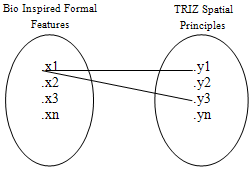 | Figure 3. Example of Relations between Domain and Range |
10.1. Symmetry
- The design process is characterized by the search for meaningful space definitions generate by knowledge. Considering the feature of symmetry, we can immediately understand that the concept in itself is closely related to the CAD concept of copy, reflection, rotation, translation or combination of these and with the natural concept of create.Symmetry acts to balance and ensure stability in relation with the center. We can find different examples in the (1) animal kingdom, where this configuration reduces the use of energy during the movement of objects in motion; (2) vegetal kingdom where the development of shapes starting from a fixed point constitutes the best criterion for the structural disposition against gravity, tending to be more stable, using a smaller quantity of material; (3) minerals, where there is a reduced scale of movement. Symmetry is the only one way to develop an ordered growth starting from the regular geometrical structures. In the biological area we encounter principally four kinds of symmetry: axial, bilateral, radial and crystalline. Symmetry prevails more in radiating and concentric arrangements, otherwise the relation is established from the side, or from above or below in the case of spirals. This property is frequently observed in crystals, plants and animals.
10.1.1. Table Captions
- Table 5 shows two examples. In the first, we show the analogy between the bio inspired formal feature used by the Jellyfish and the patent n. 5603277. The improvements in relation with the previous patents are supplied by the reduction in size and weight, which are inconvenient for carriage and storage and have a high cost. The structure is stronger, more stable, durable and reliable. On the right side we can see the patent 3899953 that uses a tube and a plurality of fins to stabilize the rotation; by arranging the rocket composition around the center, the rocket maintains the correct course, coiling and with unimpeded flight.
10.1.2. Table Captions
- Table 6 has been developed analysing data, from a number of 10 patents (selected from a group of 30 per BF Feature), and 10 bio-samples to establish relations among functions, sustainable and innovative spatial principles and so on.
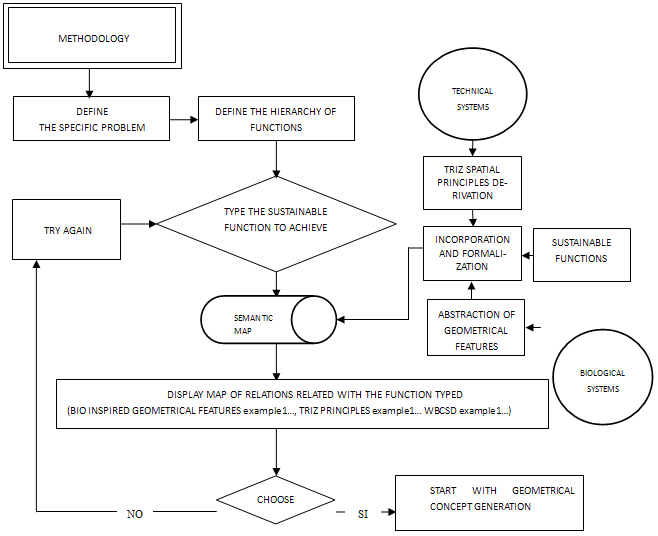 | Diagram 1. Diagram of the methodology’s structure |
| |||||||||||||||||||
|
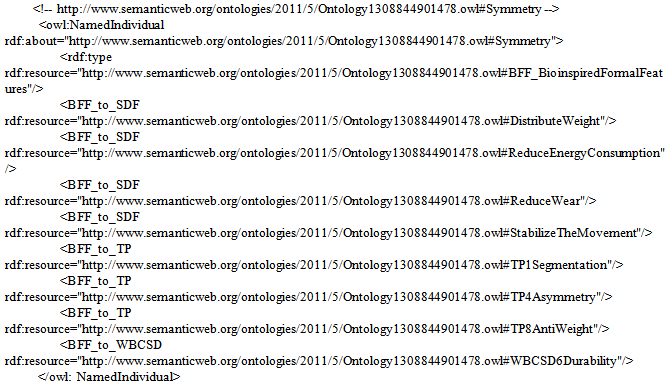
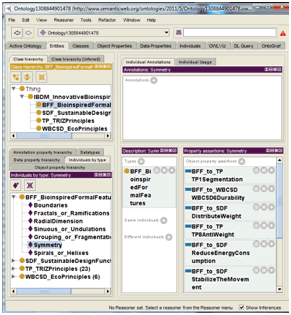 | Figure 4. Classes, individuals and properties used in the methodology. |
11. Conclusions
- The present methodology is based on the use of simplified bio inspired geometrical features as source of innovation in order to integrate those in our products. One advantage to use simplified geometries is that they can be computationally examined for following refinements.Computer aided information, innovation and design can create generative social environments that team work can expand to collaborate reducing efforts. Create all the relations, in order to push the innovation towards efficiency, makes more visible new and useful connections to stimulate creativity.My research is in development and the idea is to connect all the analogies with images to support, and to better explain the meanings related with.Further studies are required in order to expand the map, considering also the bio-geometrical risks related with time (speed) and space (size).
References
| [1] | Coyne, R. D., Rosenman, M. A., Radford, A. D., Balachandran, M., & Gero, J. S. (1990). Knowledge-Based Design Systems. US: Addison Wesley Publishing Company |
| [2] | Simon, H. A. (1983). Search and Reasoning in Problem Solving. Artificial intelligence |
| [3] | Leon, N. (2009, June). The future of computer aided innovation. Elsevier, Monterrey, Mexico |
| [4] | Newell, A., & Simon, H.. (1972) Human Problem Solving. N.J. Englewood Cliffs |
| [5] | Altshuller, G. (1999). The innovation algorithm: TRIZ, systematic innovation and technical creativity. United States of America: Technical Innovation Center |
| [6] | Cascini, G. (2004). State of the Art and Trends of Computer-Aided Innovation Tools, Towards the integration within the Product Development Cycle. Springer, Florence, Italy |
| [7] | Savransky, D. S. (2000). Engineering of Creativity, Introduction to TRIZ Methodology of Inventive Problem Solving. Florida: CRC Press |
| [8] | Chesbrough, H. (2003). Open Innovation, The New Imperative for Creating and Profiting from Technology. United State of America: Harvard Business School Publishing Corporation |
| [9] | McLoughlin, Ian. (1999). Creative Technological Change, the shaping of Technology and Organizations, The management of Technology and Innovation. New York: Routledge |
| [10] | Otto, K., Wood, K. (2001). Product Design, Techniques in Reverse Engineering and New Product Development. New Jersey: Prentice Hall |
| [11] | Pahl, G., & Beitz, W. (1977). Engineering Design. Berlin: Springer Verlag |
| [12] | Ulrich T. S., & Eppinger D. S.. 2012. Product design and Development. McGraw- Hill, New York |
| [13] | Spillers, W. R. (1974). Basic Questions of Design Theory. North-Holland Publishing Company |
| [14] | Bar-Cohen, Y. (2006). Bio-mimetic, Biologically Inspired Technologies. USA: Taylor & Francis |
| [15] | Lucien, G. (1923). Bionics, translated from the French by Pat Priban (1968). London: Weidenfeld & Nicolson |
| [16] | Vincent, G. F., Bogatyreva, O. A., Bogatyrev, N.R., Bowyer A. & Pahl, A. K. (2006, April) Bio-Mimetics: practice and theory |
| [17] | Benyus, J. M. (1997). Innovation inspired by the nature. USA: Harper Collins Publishers |
| [18] | http://database.portal.modwest.com/. Accessed |
| [19] | Benyus, J., & Baumeister, D. "The Design Spiral." (2007). www.biomimicryinstitute.org |
| [20] | Bruck, H. A., Gershon, A. L. & Gupta, S. K. (2004). Enhancement of mechanical engineering curriculum to introduce manufacturing techniques and principles for bio-inspired product development. Proc. ASME Int. Mechanical Engineering Congress and exposition |
| [21] | Vattam, S., Helms, M., & Goel, A. K.. (2007). "Biologically-Inspired Innovation in Engineering Design: A Cognitive Study." Design Intelligence Laboratory, School of Interactive Computing, Georgia Institute of Technology, Atlanta, GA |
| [22] | Chakrabarti, A., Sarkar, P., Leelavathamma, B., & Nataraju, B. S. (2005). A Functional Representation for Aiding Biomimetic and Artificial Inspiration of New Ideas. Artificial Intelligence for Engineering Design, Analysis and Manufacturing |
| [23] | Nanda, J., Simpson, T.W., Kumara, S.R.T., & Steven B. Shooter (2006, June). A Methodology for Product Family Ontology Development Using Formal Concept Analysis and Web Ontology Language. Journal of Computing and Information Science in Engineering, PA |
| [24] | Goethe, J. W. (1994). Italian Journey. Translated by Robert R. Heitner-, edited by Thomas P. Saine and Jeffrey L. Sammons. Princeton, N.J. : Princeton University Press |
| [25] | Aristotle. (1885) The Politic of Aristotle. Oxford, Clarendon Press |
| [26] | Steadman, P. (2008). The Evolution of Design, Biological analogy in architecture and the applies arts. New York: Routledge |
| [27] | Thompson, D.W. (1945). On Growth and Form. Edited by W.E. Le Gros Clark and P.B. Medawar. Oxford: Clarendon Press |
| [28] | March, L. & Steadman P. (1971) The Geometry of Environment. London: RIBA Publications |
| [29] | Galilei, G. (1914). Discorsi e Dimostrazioni Matematiche Intorno a Due Nuove Scienze (Leiden, 1638); trans. H. Crew and A. de Salvio as Dialogues Concerning Two new Sciences. New York: Macmillan |
| [30] | Forbes, N. (2004). Imitation of life : how biology is inspiring computing |
| [31] | Morin, E. (1992). The nature of Nature. New York: P. Lang |
| [32] | Gould, J., & Gould, C. G. (2007). Animal architects: Building and evolution of intelligence. New York: Basic Books |
| [33] | Hiesinger, K., & Marcus, G. (1993). Landmarks of twentieth- Century Design. New York: Abeville Press |
| [34] | Stevens, P. (1974). Patterns in Nature. Boston: Little Brown |
 Abstract
Abstract Reference
Reference Full-Text PDF
Full-Text PDF Full-text HTML
Full-text HTML
